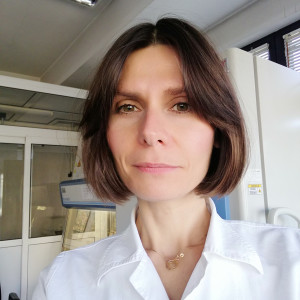Magdalena Mizerska-Kowalska

From
Maria Curie-Skłodowska University - PL
In residence at
Institute of Organic and Analytical Chemistry (ICOA) / CNRS, University of Orléans - FR
Host scientist
Prof. Pascal Bonnet
BIOGRAPHY
Dr Magdalena Mizerska-Kowalska works as associate professor in Faculty of Biology and Biotechnology at Maria Curie-Skłodowska University, Lublin, Poland. She obtained her M.Sc. (2005) and Ph.D. (2010) in field of biological sciences from the same University. Magda completed the internships: “3D cell cultures – models for biomaterials testing and osteogenesis studies” in Independent Unit of Tissue Engineering and Regenerative Medicine, Medical University, Lublin and “Methods of synthesis of hydroxyapatite-based biomaterials” in Institute of High Pressure Physics of the Polish Academy of Sciences, Warsaw, Poland. Her work is focused on cellular and molecular mechanisms of activity of semi-synthetic and synthetic compounds and natural extracts exerting antitumor potential, and biomaterials used in bone tissue regenerative medicine and in osteosarcoma treatment as drug delivery systems. Magda applied for grants of National Science Center of Poland and patents of the Republic of Poland.
PROJECT
Design of ERK2 inhibitors for cancer therapy
Constitutive activation of the extracellular signal–regulated kinase (ERK1/2) pathway drives the proliferation and survival of many cancer cell types. This is mediated among others via mutations of upstream activators of ERK1/2, including Raf kinases, e.g. BRAF. These phenomena are especially pronounced in cells harboring V600E (BRAF mutation). Therefore, the new approaches, i.e. small molecular weight compounds targeting directly hyperactivated ERK 1/2 via disrupting it interactions with up- or downstream molecules are widely explored as anticancer compounds. Recently, a small chemical library of compounds containing a 1,1-dioxido-2,5-dihydrothiophen-3-yl 4-benzenesulfonate scaffold that target the docking site for ERK/FXF (DEF domain) for substrate recruitment was synthesized. These studies determined that the presence of a double bond in the sulfur heterocycle is a key chemical feature required for exhibiting anticancer activity. This prompted us to design and synthesize a set of new molecules based on this scaffold and with modification at position 4 of the heterocycle. The preliminary in vitro studies indicated that these newly synthesized compounds exert antitumor potential towards osteosarcoma and colon cancer cells. To gain insight into molecular mechanisms of their activity, the current project is focused on the exploration of potential targets of these new compounds by means of in silico studies, e.g. molecular docking, molecular dynamics simulations, quantitative structure-activity relationship, etc.

